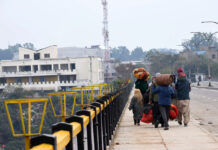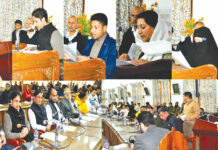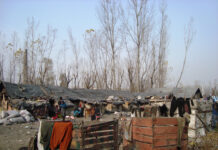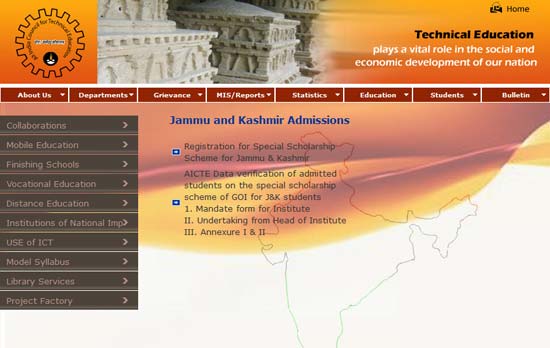The reasons behind the Dastgeer Sb. Shrine are yet not known but a number of theories are doing the rounds. Bilal Handoo Reports.
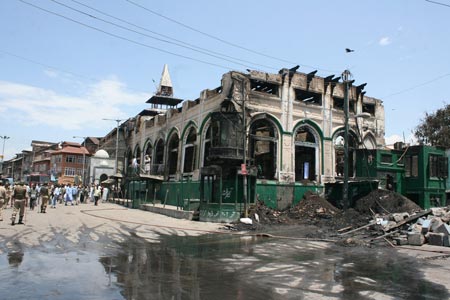
One popular theory in circulation is the ‘green turban theory’. The night before the blaze, a number of green turbaned men had stayed inside the shrine for a religious congregation, “They left the shrine premises soon after the dawn prayers. Within minutes of their departure, flames appeared in shrine,” Mohammad Amin Bhat, who offered morning prayers in shrine, said. Another theory doing the rounds blames the fire on a purported short circuit inside the shrine which triggered the blaze. However, it is very unlikely since there was no load on the wires. The shrine complex was almost closed and most of the lights were switched off, “In our homes when load increases, the fuse burns and the current disconnects. Didn’t the shrine have such an arrangement?” Mushtaq Khan, a local asks.
Though the custodian of the shrine has been talking incessantly but his knowledge is allegedly second-hand. He was not seen at Fajr prayers and even his claim that he rescued the relics is termed as untrue.
A group of local youth allegedly thrashed him for lying to the media and not acknowledging their role in the rescue operation. The fire was spotted inside a minaret of the shrine when a cop deployed at the shrine saw smoke billowing out of the minaret. “Since this area of the shrine is out of reach, I couldn’t do anything except raise an alarm.” The guard wants to remain anonymous as an enquiry is going on.
Amir, a gym regular, became a fire fighter when he saw the shrine afire. “I saw the fire at three different places of shrine, quite distant from one another,” he said. “How is it possible?”People living around the shrine are raising questions about how the fire was detected on three minarets almost at the same time.
Residents allege that the fire-fighters were extinguishing flames of the newly built mosque while the blaze in the old shrine complex was overlooked. “We constantly told a fireman to douse the fire of shrine first. To our dismay, his vehicle ran out of water,” said Abdul Rehman, a local.
Once the fire engines ran out of water, the locals allegedly prevented Fire Service from using water of Brari Nambal lagoon. “Our priority was to save the shrine and in the given situation it was the only place from where water could have been obtained,” says Dr G A Bhat, Director General of Fire Services and Emergency. “The fact of the matter is that my best men were on the job with efficient machineries but the public interference proved to be a setback.”
“There were three hydrants – one each at Mir Masjid, on the road to Babademb and Kaw Mohalla exit in the area. Why were not they used to refill the fire engines?” Showkat Ahmad, a local asks. But Mr Bhat says all the three were put to use despite low pressure. “But some miscreants cut the pipes connected to them.”
“A single fire brigade vehicle contains 7500 liters of water and it jets out 2280 liters of water per minute, which means water in one vehicle lasts only for about four minutes.
33 fire dousing vehicles were on spot which carried 2.5 lakh litres of portable water. 23 vehicles were damaged and one was set afire while three others were taken away by miscreantswhich were laterretrieved by the police,”says Mr Bhat. Bhat also denies that his force turned up late at the shrine. “It was 0630 hours when a call from a number,8803327642, informed us about the fire. By 0631 hrs, the fighters had left and by 0637 hrs, they were on spot. The CCTV footage can prove it clearly,” says Mr Bhat.
Firefighters claim that their efforts were overlooked as the blaze preoccupies memory. “If we did not act, who saved the chain of residential houses behind the shrine premises? Along with my colleagues and locals, we retrieved the holy relics from the burning shrine” claims Muhammad Sultan, a firefighter. The Directorate of Fire Services had issued a circular in 2004 recommending the use of non-inflammable paints for wooden shrines across Kashmir which could preventfire along with fire extinguishers and CCTVs. But the VC, Muslim Waqaf Board, Prof M Y Qadri says: “In 2005, fire extinguishers and CCTVs were installed but such paints are nowhere used in Kashmir.”
(Some names of the people in this story have been changed on request)


